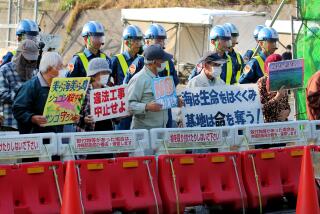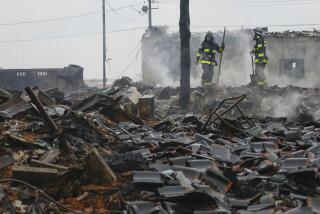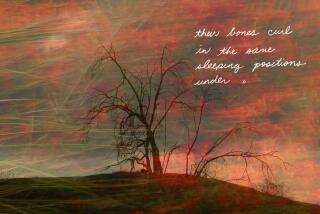Capturing Japan’s pain in 17 syllables
TOKYO — A bout the nuclear power plant
too much detail I hear
such unhappiness
First the ground shook, then the sea swallowed the land. Fires raged, lights went out, invisible menaces seeped into the air, the water, the soil.
Tears flowed and headlines blared tales of tragedy, sorrow and fear. All the words in the world, perhaps, could not capture the enormity of it all.
Amid the cacophony of news bulletins and tweets and cellphone alerts registering yet another aftershock, Yoshikatsu Kurota quietly sent out his brief verse. It was published Thursday, in small type, on Page 14 of the mass-circulation Asahi daily, in the corner that Japan’s newspapers still devote to such poetic endeavors.
Tossed like a pebble into a lake, it made not a splash but a gentle ripple. Seventeen Japanese syllables, radiating out into the universe, perhaps touching a few other distressed souls adrift in the chaos.
Mere trifle to some, a quintessence of Japan to others, maligned and beloved, the haiku endures.
In these heartsick times, aficionados of the form both here and abroad have been stirred to put brush to scroll, pen to postcard, fingers to keyboard, meshing the ancient and the modern, the sublime and the horrific.
“It’s safe, but”
they say over and over
that’s worrisome
Tadashi Nishimura’s lament (which, like most here, were written in Japanese and have been translated from the original 17 syllables) appeared alongside Kurota’s in the pages of the Asahi. The poem distills his anxiety about officials’ frequent reassurances that all is fine, even as they warn day in and out about vegetables, milk and water contaminated by radiation from the stricken nuclear power plant in Fukushima prefecture.
The two men’s compositions are technically senryuu, which follow the same syllabic rules as haiku but are typically more social commentary than, say, musings on natural phenomena such as the ephemeral beauty of a cherry blossom.
In a culture that can seem unacquainted with sarcasm, senryuu can range from mildly chiding to strikingly acerbic.
Kunio Kataoka’s submission registered his scorn for a Japanese bank whose ATM network was hobbled for days after the quake, making it difficult for victims to get much-needed cash.
We earnestly make donations
but the bank says
don’t use our system
Though the march of modernity has perhaps shrunk the number of regular haikuists in Japan, it has also expanded their options for airing the verses; besides the newspaper, there are a multitude of haiku blogs, and Twitter has become a popular forum for the pint-size poems. Still, there is a loyal following for haiku magazines such as Hototogisu, which dates to the late 1800s and whose title means “cuckoo.”
Yasuharu You, 78, a Buddhist monk from the Shin sect who leads Kyoto’s Higashi Hongan Temple, has been composing haiku since he was in high school.
When a large earthquake rocked his native Niigata in October 2004, he dove under a futon as furniture and light fixtures crashed down around him. Driven out into the frigid night, beset by unease, the haiku came to him:
It’s cold and wet
camping outdoors
aftershocks multiplying
the misery
The poem spread, and residents’ response to it was so powerful that the haiku was eventually carved onto a memorial stone in the city.
In the wake of this month’s tragedy, You composed something of a follow-up to his 2004 sensation, which Hototogisu accepted for its latest issue.
Day of disaster
I can never forget
the cold and wet
“The poet Takahama Kyoshi said haiku should be a record of daily life,” You explained. “It is not just for enjoyment; recording the tragedy of the earthquake in verse is also important.”
Haiku has among its devotees not only men of letters but men of science, some of them experts in the fields that have wreaked such havoc on Japan in recent days. The head of the Tokyo-based Haiku International Assn., Akito Arima, is a nuclear physicist
who served as president of Tokyo University, the nation’s most prestigious institute of higher education.
Former Kyoto University President Kazuo Oike, a seismologist, is another practitioner.
“I am a scientist by vocation, and so looking at nature with this eye can bring new meaning” to poetry, Oike wrote in an email.
Though he said he planned
to bide his time before composing a new haiku, in the last two decades he often has been inspired by nature’s fury.
The big tsunami
scattering as far as here
a cloud of seabirds
Boats cars
houses and people in the flow
western wind
David McMurray, a professor at the International University of Kagoshima who edits the Asahi newspaper’s biweekly English poetry feature, Asahi Haikuist Network (www.asahi.com/english/haiku), has been sorting through submissions for his April 1 edition.
In normal times, he gets about 100 contributions a day, via email, fax and even old-fashioned post. This month’s tragedy, however, has brought him a wealth of new voices.
“People write about death, love, war, anything that’s very important,” said McMurray, a Canadian. “Poetry is for catharsis, right?”
Some contributors, McMurray said, include short explanations of their compositions.
Raj Bose of Honolulu had to wait three days to get word that his son in Japan was safe. At last, a brief message came to his inbox.
“Daddy I’m fine”
time stopping and restarting
email from Tokyo
A contributor from Los Angeles, Stephen J. DeGuire, paid homage to Matsuo Basho, a 17th century haiku virtuoso whose masterwork, “The Narrow Road to the Deep North,” was inspired by his treks in the area ravaged by the March 11 disaster.
Basho’s road
throughout Tohoku
hope remains
Typically, a haiku will include a special word or phrase, called a kigo, that signals what season the poem is about. One such phrase is “spring sea,” which this year poets are appropriating to signify the tsunami.
A regular contributor, who goes by the pen name Murasaki Sagano, wrote McMurray to say her mother had died five days after the tsunami.
Mother’s pain
into the spring sea
her last sleep
--
Special correspondent Hikari Uchiyama in Tokyo contributed to this report.
More to Read
Sign up for Essential California
The most important California stories and recommendations in your inbox every morning.
You may occasionally receive promotional content from the Los Angeles Times.











